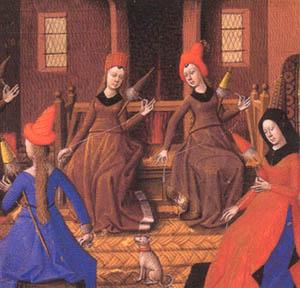 |
Catholic Customs
A Study of the Veil in the Christian Tradition - Part 6
What Does Canon Law Say about the Veil?
Donald P. Goodman III
4.2 Ecclesiastical Law
Thus far I have spoken entirely about the tradition of the veil. We have seen that that tradition is universally supported by the Fathers, Doctors, and other theologians, that it is firmly rooted in the tradition passed down by the Apostles, and that it is has been codified for us in Holy Writ. Until now, however, we have not looked at the veil in ecclesiastical law. Has the Church ever legislated about the veil?

Marie of Burgundy wears the late 15th-century fashion of headdress, the elaborate bennin
Portrait of Mary of Burgundy, Flemish, 15th c. |
As in most ancient traditions of any import, the Church has indeed legislated concerning the veil, and that legislation existed until much more recently than would be expected. The laws of the Church are ever obedient to the wishes of Our Lord and Savior, in this matter as in any other: they mandated the veil for women at least when in a church or at a liturgical celebration.
While in very ancient times there is no record of the veil being codified in a system of law [except for a probably apocryphal decree of Pope Linus, (1) the explanation for this absence is fairly predictable. The time was so remote and so troubled that it is a wonder that any of its writings came down to us at all. We cannot expect each minute decree of every leader to remain in existence, clear and intact, over the course of nearly 2,000 very tumultuous years. For the behavior of women at that period of time, we can rely only on the traditions that have been passed down to us, which clearly mandate the practice of the veil. For the practices of less remote ages, however, some laws for our guidance have survived.
Of particular interest is The Code of Canon Law, the norms of which are binding on all Catholics. From 1917 until 1983, The Code of Canon Law of 1917 was in force throughout the Church; it contained many regulations which were not renewed in the new Code promulgated in 1983. One of those regulations was on head coverings in Church, addressed to both men and women.
Men, of course, were required to appear with “a naked head,” (2) except when “the tested customs of the people or the accompanying peculiarity of things bears otherwise.” (3) For women, however, the regulation is considerably more stringent. There are no exceptions made for women; they simply must wear the veil.
The Code does not give reasons for its mandate; it is simply a statement of rules, not a justification of them. However, it is unambiguous that, until 1983, the laws of the Church required women to wear the veil at least in churches. The Code states clearly that women, while “in a church or while assisting with the sacred rites outside of a church” ought to appear “with the head entirely covered ... especially when they approach the Lord ’s Table.” (4) There are no exceptions, no “unless” clauses. That was simply the law of the Church.
Moreover, the Code sounds much like St. John Chrysostom, requiring the head to be “completely covered,” not simply partially concealed. Most authors have used the word “velare, ” which means simply “to cover,” to refer to woman’s obligations to cover themselves. The Code, however, used the word “cooperire,” which has a much stronger meaning, referring to a total covering of its object.

Women Spinning Wool with Distaffs
Valerius Maximus, French, c. 1475 |
Lest I assume too strong an interpretation of this word, I note that the custom at the time of the Code’s promulgation and thereafter consisted not of a complete covering, but simply a hat or mantilla that concealed at least the top and usually most of the hair, and that the Church made no effort to alter this custom after the promulgation of the Code.
I can conclude, then, that the use of the stronger word was most likely to discourage the practice of a covering that is next to useless but still fulfils the precept of having something on the head, following the letter rather than the spirit. The Church is ever watchful for such legalism, for as St. Paul tells us, “the letter killeth, but the spirit quickenet.” (II Corinthians 3:6).
Many, however, will view these dates with confusion. Surely 1983 is not the correct year, they might object, since that was nearly 20 years after the Second Vatican Council. And was it not the recent Council that did away with such archaic practices as Latin in the Mass, the churching of women, and the wearing of the veil?
The date, however, is correct; this law was fully in force until 1983, when the new Code of Canon Law was promulgated (and this Code simply omits any mention of the veil). The veil fell out of practice, however, in the mid-1960s, lasting in some places until the promulgation of the new Missal but dying out shortly thereafter. Does this really mean that for nearly 20 years most Catholic women were in violation of valid ecclesiastical law?
Yes, it does. The individual culpability of these women is totally beyond my or anyone’s ability to state, and I will consequently make no attempt to do so. There are too many factors that may have played into their decision, including ignorance of the law itself, which may have reduced or eliminated their personal guilt. Their culpability is not in question here.
What is in question is why the leaders of the Church remained silent in the face of a nearly universal abandonment of obedience to an ancient and established law. That, however, is a question that can be posed about so much of the Church’s leadership and on so many matters in these dark times; all this is beyond the scope of this brief essay to even begin to address. Suffice it to say that this law is by no means archaic or antiquated. It existed through most of the 20th century, was complied with well through over half of it, and its mere existence is at least an indication that the justifications given for it so many centuries ago remain just as powerful as they once were, and our discussion of the veil tradition is complete.
What significance, however, can this tradition, however old and venerable it might be, have in the modern world? How can we make the veil relevant to a world conquered by feminism and modernity? That will be the subject of my final section, which will conclude by discussion on the veil tradition for women.
1.J. P. Kirsch, “Linus, Pope Saint,” in The Catholic Encyclopedia. Viewed on 29 April 2004.
2. “[N]udo capite,” Codex Iuris Canonici (1917), Canon 1262, § 2 at http://www.geocities.com/catholic_profide/codex.htm. Viewed on 29 April 2004.
3. “[N]isi aliud ferant probati populorum mores aut peculiaria rerum adiuncta.” Codex Iuris Canonici, 1917.
4. “[I]n ecclesia vel extra ecclesiam, dum sacris ritibus assistunt...mulieres autem, capite cooperto [sint]...maxime cum ad mensam Dominicam accedunt.” Codex Iuris Canonici (1917), Canon 1262, § 2.

Posted July 30, 2005
Go to Introduction Part 1 Part 2 Part 3 Part 4 Part 5 Part 6 Conclusion
The pleasure TIA has to publish collaborations of our guest columnists does not imply that it endorses all the opinions expressed in their articles.
Return to TOP

Related Topics of Interest
 Restoration: Let's Begin with the Veil Restoration: Let's Begin with the Veil
 St. Pius X on Priestly Dignity and Propriety St. Pius X on Priestly Dignity and Propriety
 Titles and Signs of Respect for Priests and Religious Titles and Signs of Respect for Priests and Religious
 Why Shouldn't Women Wear Trousers Today? Why Shouldn't Women Wear Trousers Today?

Related Works of Interest
|
Catholic Customs | Religious | Home | Books | CDs | Search | Contact Us |
Donate

© 2002- Tradition in Action, Inc. All Rights Reserved
|
 |
|